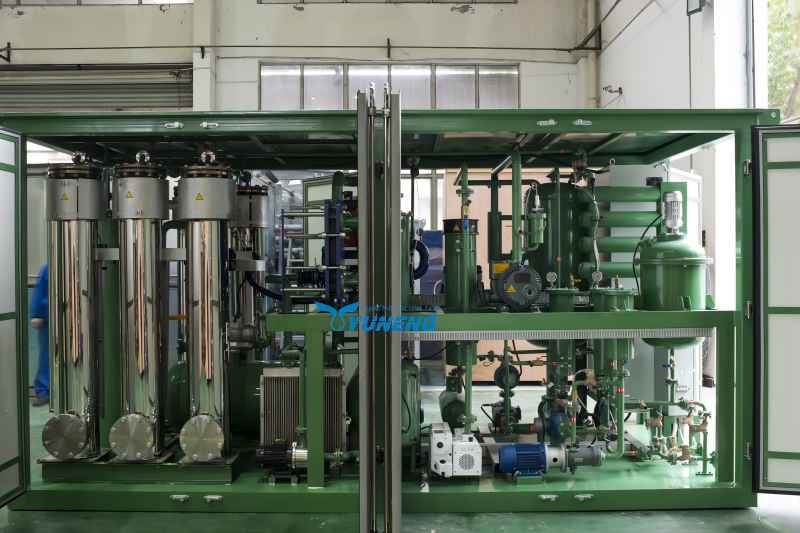How Regenerated Transformer Oil Expands Transformer Lifespan
The function of transformer oil is essential in guaranteeing the integrity and long life of transformers, offering as both an insulator and coolant. Restored transformer oil offers a compelling solution to enhance these functions by successfully getting rid of harmful impurities that compromise performance.
Significance of Transformer Oil
Transformer oil plays a critical duty in the efficient operation of electrical transformers. It mainly offers as a shielding medium, preventing electrical discharges and making sure that components operate securely under high voltage problems. The oil's dielectric buildings are fundamental to maintaining the stability of the transformer, as they lessen the danger of failures that could result in expensive downtimes or devastating events.
Along with its shielding abilities, transformer oil likewise works as a coolant. As transformers operate, they produce warmth that must be dissipated to stop overheating and succeeding damages. The oil circulates within the transformer, taking in and moving warmth away from crucial parts, consequently maintaining optimum operating temperatures.
In addition, transformer oil functions as a barrier versus moisture and pollutants, which can compromise the performance and long life of the transformer. Its chemical properties assist in neutralizing acids and various other byproducts that might create gradually, adding to the overall wellness of the electrical system.
Benefits of Regenerated Oil

Furthermore, regenerated transformer oil has a reduced degree of impurities, including fragments and impurities that can deteriorate performance. This pureness not just boosts the oil's thermal conductivity but also prolongs the functional life-span of transformers by minimizing overheating dangers. The enhanced thermal security of restored oil makes certain consistent performance even under high operating temperatures, which is crucial for keeping transformer performance.
An additional advantage is its ecological impact. Regrowed oil promotes sustainability by reducing waste and the need for new oil production, thereby reducing the carbon impact connected with transformer upkeep. Reclaimed Transformer Oil. The long life of restored oil translates to reduced upkeep expenses over time, as fewer oil adjustments and much less regular devices downtime are required.
Process of Oil Regrowth
The regrowth of transformer oil includes a methodical process developed to bring back the oil's initial buildings and boost its efficiency. This process generally begins with the elimination of the used oil from the transformer, which is after that based on various filtration strategies.
The very first step in the regrowth process is the filtration, where strong contaminants such as dirt, steel, and sludge fragments are removed. This is usually adhered to by vacuum distillation, which helps to get rid of wetness and unstable compounds, thereby boosting the oil's dielectric toughness.

Influence On Transformer Efficiency
Recovering the residential properties of regenerated transformer oil substantially influences the overall performance of transformers. Boosted dielectric strength is just one of the most vital benefits, as it enables much better insulation and decreases the likelihood of electric malfunction. This renovation results in a much more secure procedure under high voltage conditions, ultimately causing raised efficiency.
Furthermore, the elimination of impurities and degradation products during the regrowth process reduces the threat of getting too hot. Cleanser oil promotes far better warmth dissipation, which is essential for preserving optimal operating temperature levels. As an effect, the thermal performance of the transformer is improved, permitting for greater tons without jeopardizing integrity.
In addition, the chemical stability of restored oil makes sure prolonged functional life. It resists oxidation and deterioration, minimizing the regularity of upkeep interventions and oil substitute. This stability not just adds to enhanced efficiency however also straightens with sustainability goals by decreasing waste.
Future of Transformer Maintenance
As advancements in innovation continue to improve the landscape of electrical design, the future of transformer maintenance is poised for considerable change. The integration of clever innovations, such as IoT sensing units and predictive analytics, makes it possible for real-time surveillance of transformer wellness, boosting the ability to preemptively deal with concerns prior to they escalate right into significant failings. This proactive strategy not just takes full advantage of operational effectiveness but likewise extends the life expectancy of transformers.
In addition, the application of expert system (AI) in information analysis enables for even more exact mistake detection and medical diagnosis. By leveraging artificial intelligence formulas, maintenance teams can identify patterns in functional information that human analysts may ignore, leading to even more Reclaimed Transformer Oil educated decision-making.
In addition, the adoption of eco-friendly techniques, including the use of regenerated transformer oil, is established to redefine maintenance methods. This lasting technique not just decreases environmental effect but likewise improves the total health of the transformer.
Last but not least, the change towards automation in upkeep procedures is expected to improve procedures, reduce downtime, and reduced prices. As these developments remain to progress, the future of transformer upkeep will unquestionably become more efficient, reliable, and lasting, making sure the integrity of important electric infrastructure.
Final Thought
The use of regenerated transformer oil significantly improves the functional longevity of transformers. By successfully bring back dielectric strength and thermal security, this oil plays a critical duty in mitigating dangers connected with overheating and oxidation. The regeneration process not only removes dangerous pollutants but also reduces upkeep frequency and oil substitute expenses. Ultimately, the adoption of regrowed oil represents a pivotal improvement in transformer upkeep, guaranteeing optimum efficiency and sustainability in the administration of electrical facilities.
The role of transformer oil is crucial in making certain the dependability and durability of transformers, serving as both an insulator and coolant.Transformer oil plays an important role in the reliable operation of electrical transformers. Restored oil promotes sustainability by minimizing waste and the need for new oil production, thereby lowering the carbon footprint associated with transformer upkeep.Recovering the properties of regenerated transformer oil dramatically influences the total efficiency of transformers.The usage of regenerated transformer oil significantly improves the functional long life of transformers.
Comments on “The Duty of a Transformer Oil Regeneration Plant in Modern Market”